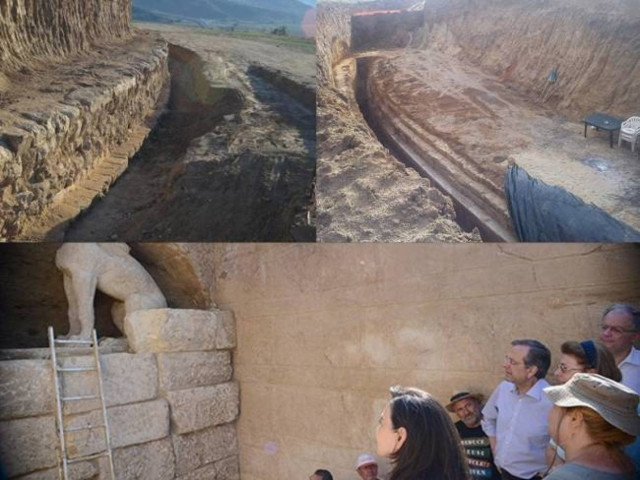History meets mystery in ancient Amphipolis; Assumptions over royal tomb monument
Excavations conducted in Casta Tomb, in ancient Amphipolis seem to be revealing a unique world monument.

Several questions are raised after department of ancient monuments in northern Greece is close to what could be the top of an ancient royal tomb.
After years of research and excavations archaeologists are now reaching conclusions, regarding the origins of the monument.
According statements made during the development of the excavations by head of KH Ephorate of Antiquities, Katerina Peristeri, major historical events had taken place in the area of Amphipolis.
The tomb dates back to 325-300 BC and reportedly bears the signature of famous ancient architect Dinocrates, a close friend of Alexander the Great.
Assumptions were made that the royal tomb could belong either to major general of Alexander the Great era or to Alexander's the Great wife, Roxanne, or his son, Alexander the fourth, as this area is related to their ordered exile and murder by Cassander.
The area is being guarded by the police while the Greek Ministry of Culture and Sports is monitoring ongoing developments.
Samaras visits ancient Amphipolis
Greek Prime Minister Antonis Samaras, accompanied by his wife Georgia and Culture Minister Constantinos Tassoulas, is visiting the site of Ancient Amphipolis, in northern Greece. Samaras will also visit Kasta hill and will be guided through the ongoing archaeological excavation site
Prime Minister Antonis Samaras, accompanied by his wife Georgia and Culture Minister Constantinos Tassoulas, on Tuesday morning visited the excavation site of Ancient Amphipolis, in the northern Greek region of Serres.
The premier briefly met with locals at the site's refreshment facilities and urged them to "be patient for a few days."
Samaras then visited the Kasta Tomb and was guided through the excavation site by the archaeologist in charge Katerina Peristeri who briefed him on the findings.
"It is clear that we stand before an extremely important finding," he said adding that the land of Macedonia continues revealing unique treasures that "weave the unique mosaic or our Greek history."
"This is a monument with unique features: A surrounding peribolos of 497 meters, almost a perfect circle carved in Thassos marble. The Lion of Amphipolis over 5 meters high, 5.20 meters; let's imagine it as being on the top of the tomb," he said while also referring to the wide path that leads to the tomb entrance and the two Sphinxes that seem to be guarding it.
"I believe all these findings have allowed archaeologist Katerina Peristeri to be optimistic that this is a unique burial monument, which –as she said- dates between 325 and 300 BC. Regarding the key question, the excavation will reveal the identity of the deceased. The excavation will continue at a pace dictated by the finding as well as the scientific ethics," he added congratulating Peristeri and her partners.
Amphipolis newly elected mayor Constantinos Melitos told ANA-MPA that "the premier's visit means the excavation is expected to reveal something significant" and added that the "area and the whole of Greece will become known around the world."
























